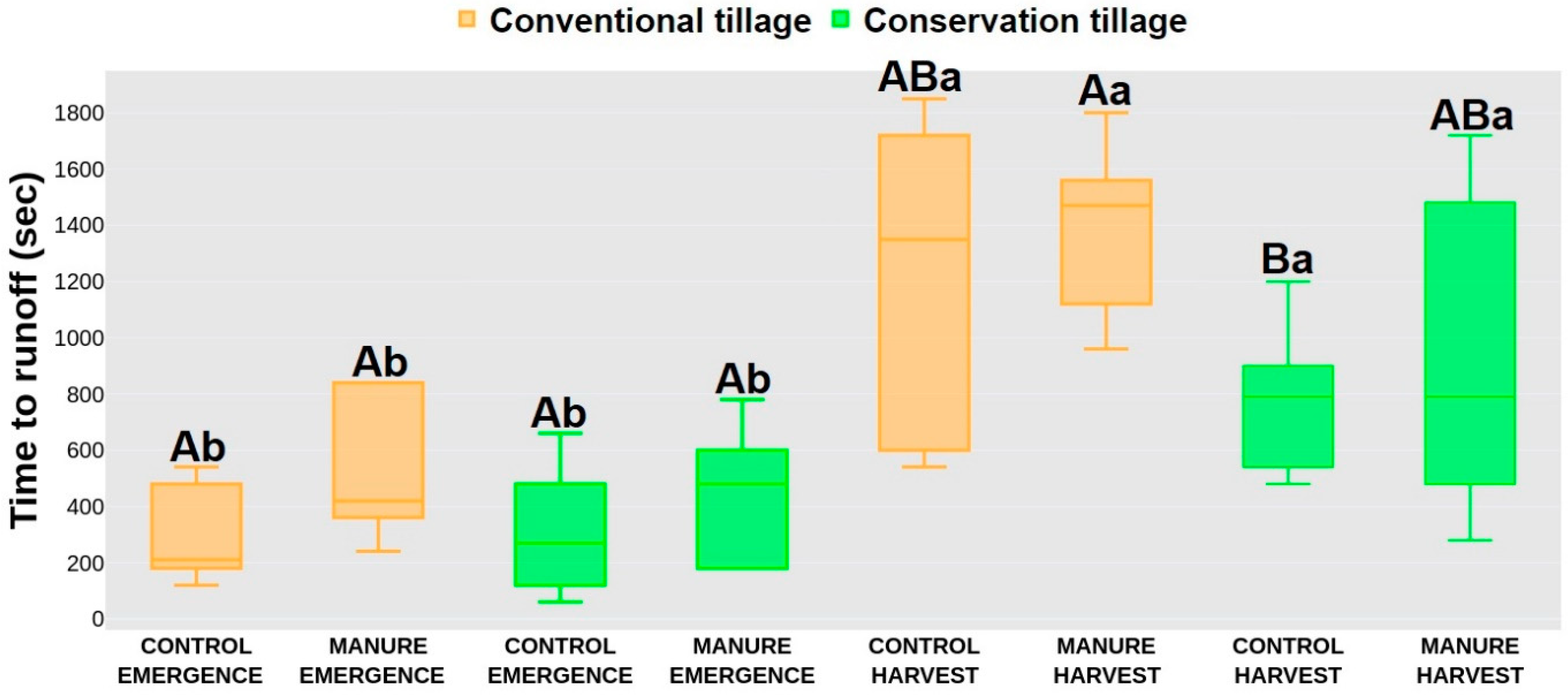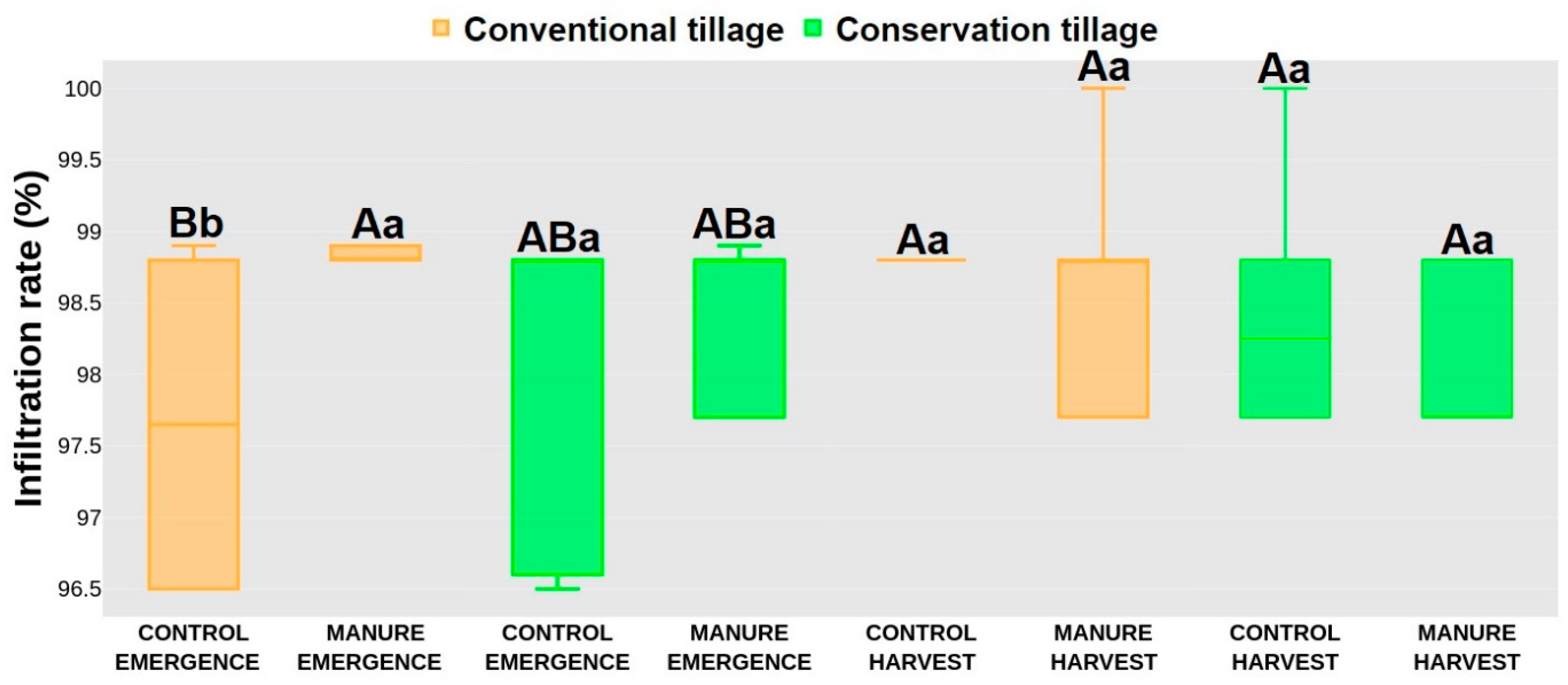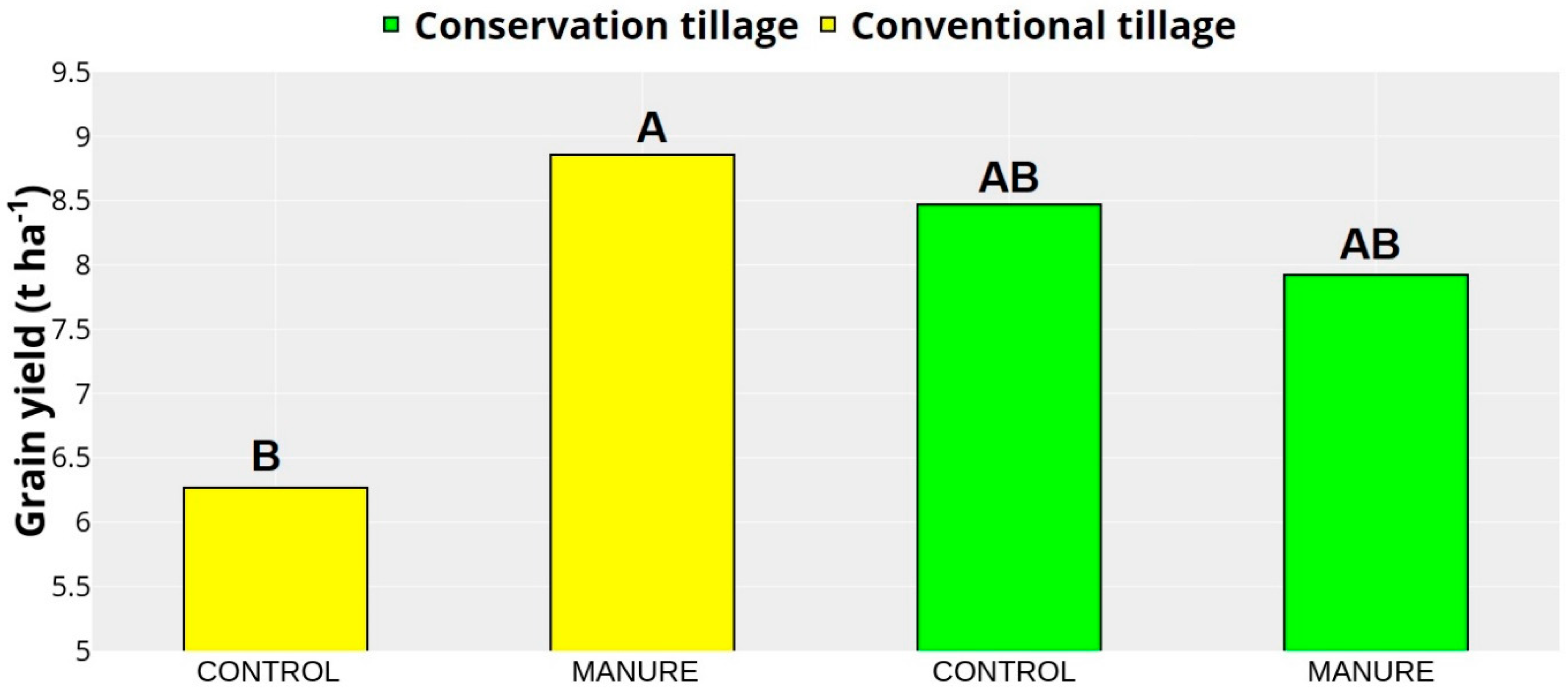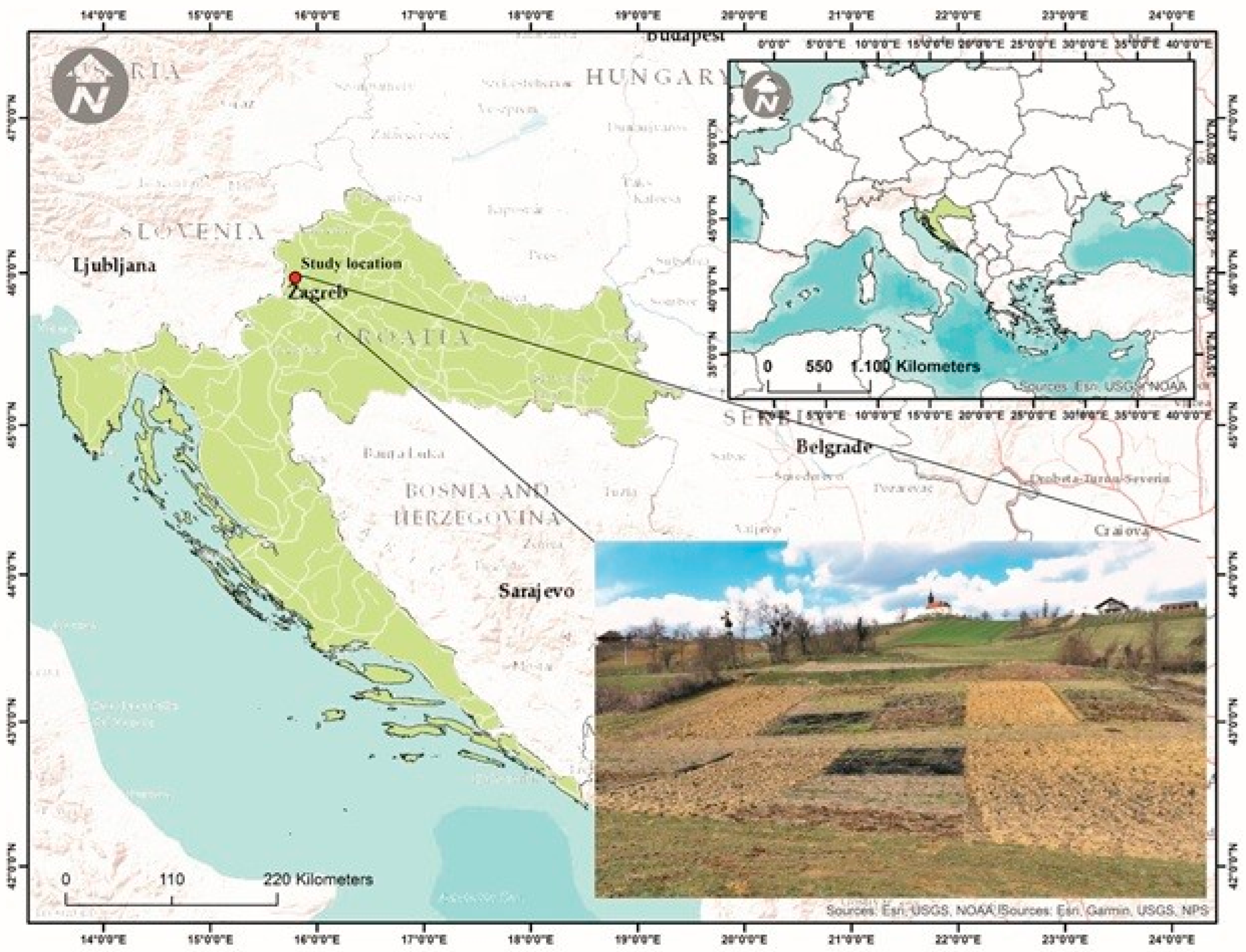Analyzing the Influence of Conservation Tillage and Manure on Soil Parameter Modulations in Croplands
Abstract
:1. Introduction
2. Results
2.1. Soil Physicochemical Properties
2.2. Hydrological Response
2.3. Crop Yield
3. Discussion
3.1. Soil Properties
3.2. Hydrology Response
3.3. Grain Yield
3.4. Implications for Management
3.5. Study Limitations
4. Materials and Methods
4.1. Study Area
4.2. Experimental Design
4.3. Fieldwork
4.4. Laboratory Analysis
4.5. Statistical Analysis
5. Conclusions
Author Contributions
Funding
Data Availability Statement
Acknowledgments
Conflicts of Interest
References
- Lal, R. Soil organic matter content and crop yield. J. Soil Water Conserv. 2020, 75, 27A–32A. [Google Scholar] [CrossRef]
- Guo, Q.; Hao, Y.; Liu, B. Rates of soil erosion in China: A study based on runoff plot data. Catena 2015, 124, 68–76. [Google Scholar] [CrossRef]
- Pimentel, D.; Burgess, M. Soil erosion threatens food production. Agriculture 2013, 3, 443–463. [Google Scholar] [CrossRef]
- Kisic, I.; Bogunovic, I.; Birkás, M.; Jurisic, A.; Spalevic, V. The role of tillage and crops on a soil loss of an arable Stagnic Luvisol. Arch. Agron. Soil Sci. 2017, 63, 403–413. [Google Scholar] [CrossRef]
- Alcántara, V.; Don, A.; Well, R.; Nieder, R. Deep ploughing increases agricultural soil organic matter stocks. Glob. Chang. Biol. 2016, 22, 2939–2956. [Google Scholar] [CrossRef] [PubMed]
- Bogunovic, I.; Pereira, P.; Kisic, I.; Sajko, K.; Sraka, M. Tillage management impacts on soil compaction, erosion and crop yield in Stagnosols (Croatia). Catena 2018, 160, 376–384. [Google Scholar] [CrossRef]
- Pagliai, M.; Vignozzi, N.; Pellegrini, S. Soil structure and the effect of management practices. Soil Till. Res. 2004, 79, 131–143. [Google Scholar] [CrossRef]
- Vian, J.F.; Peigné, J.; Chaussod, R.; Roger-Estrade, J. Effects of four tillage systems on soil structure and soil microbial biomass in organic farming. Soil Use Manag. 2009, 25, 1–10. [Google Scholar] [CrossRef]
- Tromp-van Meerveld, H.J.; Parlange, J.Y.; Barry, D.A.; Tromp, M.F.; Sander, G.C.; Walter, M.T.; Parlange, M.B. Influence of sediment settling velocity on mechanistic soil erosion modeling. Water Resour. Res. 2008, 44. [Google Scholar] [CrossRef]
- Bronick, C.J.; Lal, R. Soil structure and management: A review. Geoderma 2005, 124, 3–22. [Google Scholar] [CrossRef]
- Shokati, B.; Ahangar, A.G. Effect of conservation tillage on soil fertility factors: A review. Int. J. Biosci. 2014, 4, 144–156. [Google Scholar] [CrossRef]
- Karlen, D.L.; Kovar, J.L.; Cambardella, C.A.; Colvin, T.S. Thirty-year tillage effects on crop yield and soil fertility indicators. Soil Till. Res. 2013, 130, 24–41. [Google Scholar] [CrossRef]
- Seitz, S.; Goebes, P.; Puerta, V.L.; Pereira, E.I.P.; Wittwer, R.; Six, J.; van der Heijden, M.G.A.; Scholten, T. Conservation tillage and organic farming reduce soil erosion. Agron. Sustain. Dev. 2019, 39, 4. [Google Scholar] [CrossRef]
- Gholami, L.; Sadeghi, S.H.R.; Homaee, M. Different effects of sheep manure conditioner on runoff and soil loss components in eroded soil. Catena 2016, 139, 99–104. [Google Scholar] [CrossRef]
- Bogunović, I.; Hrelja, I.; Kisić, I.; Dugan, I.; Krevh, V.; Defterdarović, J.; Filipović, V.; Filipović, L.; Pereira, P. Straw Mulch Effect on Soil and Water Loss in Different Growth Phases of Maize Sown on Stagnosols in Croatia. Land 2023, 12, 765. [Google Scholar] [CrossRef]
- Mohammed, S.; Hassan, E.; Abdo, H.G.; Szabo, S.; Mokhtar, A.; Alsafadi, K.; Rodrigo-Comino, J. Impacts of rainstorms on soil erosion and organic matter for different cover crop systems in the western coast agricultural region of Syria. Soil Use Manag. 2021, 37, 196–213. [Google Scholar] [CrossRef]
- Amini, S.; Asoodar, M.A. Investigation on the effect of conservation tillage on soil organic matter (SOM) and soil organic carbon (SOC): The review. N. Y. Sci. J. 2015, 8, 15–25. [Google Scholar]
- Li, H.; Gao, H.; Wu, H.; Li, W.; Wang, X.; He, J. Effects of 15 years of conservation tillage on soil structure and productivity of wheat cultivation in northern China. Soil Res. 2007, 45, 344–350. [Google Scholar] [CrossRef]
- Puerta, V.L.; Pereira, E.I.P.; Wittwer, R.; Van Der Heijden, M.; Six, J. Improvement of soil structure through organic crop management, conservation tillage and grass-clover ley. Soil Till. Res. 2018, 180, 1–9. [Google Scholar] [CrossRef]
- Blanco-Canqui, H.; Lal, R. Crop residue removal impacts on soil productivity and environmental quality. Crit. Rev. Plant Sci. 2009, 28, 139–163. [Google Scholar] [CrossRef]
- Van Donk, S.J.; Martin, D.L.; Irmak, S.; Melvin, S.R.; Petersen, J.L.; Davison, D.R. Crop residue cover effects on evaporation, soil water content, and yield of deficit-irrigated corn in west-central Nebraska. Trans. ASABE 2010, 53, 1787–1797. [Google Scholar] [CrossRef]
- Salinas-Garcia, J.R.; Hons, F.M.; Matocha, J.E. Long-term effects of tillage and fertilization on soil organic matter dynamics. Soil Sci. Soc. Am. J. 1997, 61, 152–159. [Google Scholar] [CrossRef]
- Karlen, D.L.; Wollenhaupt, N.C.; Erbach, D.C.; Berry, E.C.; Swan, J.B.; Eash, N.S.; Jordahl, J.L. Long-term tillage effects on soil quality. Soil Till. Res. 1994, 32, 313–327. [Google Scholar] [CrossRef]
- Bessam, F.; Mrabet, R. Long-term changes in soil organic matter under conventional tillage and no-tillage systems in semiarid Morocco. Soil Use Manag. 2003, 19, 139–143. [Google Scholar] [CrossRef]
- Büchi, L.; Wendling, M.; Amossé, C.; Jeangros, B.; Sinaj, S.; Charles, R. Long and short term changes in crop yield and soil properties induced by the reduction of soil tillage in a long term experiment in Switzerland. Soil Till. Res. 2017, 174, 120–129. [Google Scholar] [CrossRef]
- Rice, C.W. Organic matter and nutrient dynamics. In Encyclopedia of Soil Science, 2nd ed.; Taylor and Francis Group: Boca Raton, FL, USA, 2002; pp. 1180–1183. [Google Scholar]
- Zingore, S.; Delve, R.J.; Nyamangara, J.; Giller, K.E. Multiple benefits of manure: The key to maintenance of soil fertility and restoration of depleted sandy soils on African smallholder farms. Nutr. Cycl. Agroecosyst. 2008, 80, 267–282. [Google Scholar] [CrossRef]
- Larney, F.J.; Hao, X.; Topp, E. Manure management. In Soil Management: Building a Stable Base for Agriculture; Wiley: Hoboken, NJ, USA, 2011; pp. 245–263. [Google Scholar] [CrossRef]
- Riley, H.; Pommeresche, R.; Eltun, R.; Hansen, S.; Korsaeth, A. Soil structure, organic matter and earthworm activity in a comparison of cropping systems with contrasting tillage, rotations, fertilizer levels and manure use. Agric. Ecosyst. Environ. 2008, 124, 275–284. [Google Scholar] [CrossRef]
- de Melo, T.R.; Figueiredo, A.; Machado, W.; Tavares Filho, J. Changes on soil structural stability after in natura and composted chicken manure application. Int. J. Recycl. Org. Waste Agric. 2019, 8, 333–338. [Google Scholar] [CrossRef]
- Panagos, P.; Montanarella, L.; Barbero, M.; Schneegans, A.; Aguglia, L.; Jones, A. Soil priorities in the European Union. Geoderma Reg. 2022, 29, e00510. [Google Scholar] [CrossRef]
- Heuser, I. Soil Governance in current European Union Law and in the European Green Deal. Soil Secur. 2022, 6, 100053. [Google Scholar] [CrossRef]
- Gicheru, P.; Gachene, C.; Mbuvi, J.; Mare, E. Effects of soil management practices and tillage systems on surface soil water conservation and crust formation on a sandy loam in semi-arid Kenya. Soil Till. Res. 2004, 75, 173–184. [Google Scholar] [CrossRef]
- Goldberg, N.; Nachshon, U.; Argaman, E.; Ben-Hur, M. Short term effects of livestock manures on soil structure stability, runoff and soil erosion in semi-arid soils under simulated rainfall. Geosciences 2020, 10, 213. [Google Scholar] [CrossRef]
- Martín-Lammerding, D.; Gabriel, J.L.; Zambrana, E.; Santín-Montanyá, I.; Tenorio, J.L. Organic amendment vs. Mineral fertilization under minimum tillage: Changes in soil nutrients, soil organic matter, biological properties and yield after 10 years. Agriculture 2021, 11, 700. [Google Scholar] [CrossRef]
- Materechera, S.A. Tillage and tractor traffic effects on soil compaction in horticultural fields used for peri-urban agriculture in a semi-arid environment of the North West Province, South Africa. Soil Till. Res. 2009, 103, 11–15. [Google Scholar] [CrossRef]
- Badalíková, B. Influence of soil tillage on soil compaction. In Soil Engineering; Springer: Berlin/Heidelberg, Germany, 2010; pp. 19–30. [Google Scholar] [CrossRef]
- Sidhu, D.; Duiker, S.W. Soil compaction in conservation tillage: Crop impacts. Agron. J. 2006, 98, 1257–1264. [Google Scholar] [CrossRef]
- Afzalinia, S.; Zabihi, J. Soil compaction variation during corn growing season under conservation tillage. Soil Till. Res. 2014, 137, 1–6. [Google Scholar] [CrossRef]
- Jakab, G.; Madarász, B.; Szabó, J.A.; Tóth, A.; Zacháry, D.; Szalai, Z.; Kertesz, A.; Dyson, J. Infiltration and soil loss changes during the growing season under ploughing and conservation tillage. Sustainability 2017, 9, 1726. [Google Scholar] [CrossRef]
- Fleming, R.L.; Powers, R.F.; Foster, N.W.; Kranabetter, J.M.; Scott, D.A.; Ponder, F., Jr.; Berch, S.; Chapman, W.K.; Kabzems, R.D.; Ludovici, K.H.; et al. Effects of organic matter removal, soil compaction, and vegetation control on 5-year seedling performance: A regional comparison of Long-Term Soil Productivity sites. Can. J. For. Res. 2006, 36, 529–550. [Google Scholar] [CrossRef]
- De Neve, S.; Hofman, G. Influence of soil compaction on carbon and nitrogen mineralization of soil organic matter and crop residues. Biol. Fertil. Soils 2000, 30, 544–549. [Google Scholar] [CrossRef]
- Franzluebbers, A.J. Water infiltration and soil structure related to organic matter and its stratification with depth. Soil Till. Res. 2002, 66, 197–205. [Google Scholar] [CrossRef]
- Lampurlanés, J.; Cantero-Martínez, C. Soil bulk density and penetration resistance under different tillage and crop management systems and their relationship with barley root growth. Agron. J. 2003, 95, 526–536. [Google Scholar] [CrossRef]
- Schlüter, S.; Großmann, C.; Diel, J.; Wu, G.M.; Tischer, S.; Deubel, A.; Rücknagel, J. Long-term effects of conventional and reduced tillage on soil structure, soil ecological and soil hydraulic properties. Geoderma 2018, 332, 10–19. [Google Scholar] [CrossRef]
- Subbulakshmi, S.; Saravanan, N.; Subbian, P. Conventional tillage vs conservation tillage—A review. Agric. Rev. 2009, 30, 56–63. [Google Scholar]
- Jeřábek, J.; Zumr, D.; Dostál, T. Identifying the plough pan position on cultivated soils by measurements of electrical resistivity and penetration resistance. Soil Till. Res. 2017, 174, 231–240. [Google Scholar] [CrossRef]
- Wagner, S.; Cattle, S.R.; Scholten, T. Soil-aggregate formation as influenced by clay content and organic-matter amendment. J. Plant Nutr. Soil Sci. 2007, 170, 173–180. [Google Scholar] [CrossRef]
- Birkás, M.; Szemők, A.; Antos, G.; Neményi, M. Environmentally-Sound Adaptable Tillage; Akadémiai Kiadó: Budapest, Hungary, 2008; 354p. [Google Scholar]
- Paustian, K.; Six, J.; Elliott, E.T.; Hunt, H.W. Management options for reducing CO2 emissions from agricultural soils. Biogeochemistry 2000, 48, 147–163. [Google Scholar] [CrossRef]
- Mikha, M.M.; Rice, C.W. Tillage and manure effects on soil and aggregate-associated carbon and nitrogen. Soil Sci. Soc. Am. J. 2004, 68, 809–816. [Google Scholar] [CrossRef]
- Six, J.; Elliott, E.T.; Paustian, K. Soil structure and soil organic matter II. A normalized stability index and the effect of mineralogy. Soil Sci. Soc. Am. J. 2000, 64, 1042–1049. [Google Scholar] [CrossRef]
- Haynes, R.J. Labile organic matter fractions as centralcomponents of the quality of agricultural soils: An overview. Adv. Agron. 2005, 5, 221–268. [Google Scholar]
- Lin, Y.; Ye, G.; Kuzyakov, Y.; Liu, D.; Fan, J.; Ding, W. Long-term manure application increases soil organic matter and aggregation, and alters microbial community structure and keystone taxa. Soil Biol. Biochem. 2019, 134, 187–196. [Google Scholar] [CrossRef]
- Mohammadi, K.; Heidari, G.; Khalesro, S.; Sohrabi, Y. Soil management, microorganisms and organic matter interactions: A review. Afr. J. Biotechnol. 2011, 10, 19840. [Google Scholar] [CrossRef]
- Turmel, M.S.; Speratti, A.; Baudron, F.; Verhulst, N.; Govaerts, B. Crop residue management and soil health: A systems analysis. Agric. Syst. 2015, 134, 6–16. [Google Scholar] [CrossRef]
- Congreves, K.A.; Hayes, A.; Verhallen, E.A.; Van Eerd, L.L. Long-term impact of tillage and crop rotation on soil health at four temperate agroecosystems. Soil Till. Res. 2015, 152, 17–28. [Google Scholar] [CrossRef]
- Kihara, J.; Bationo, A.; Mugendi, D.N.; Martius, C.; Vlek, P.L. Conservation tillage, local organic resources, and nitrogen fertilizer combinations affect maize productivity, soil structure and nutrient balances in semi-arid Kenya. In Innovations as Key to the Green Revolution in Africa: Exploring the Scientific Facts; Springer: Dordrecht, The Netherlands, 2011; pp. 155–167. [Google Scholar] [CrossRef]
- Busari, M.A.; Kukal, S.S.; Kaur, A.; Bhatt, R.; Dulazi, A.A. Conservation tillage impacts on soil, crop and the environment. Int. Soil Water Conserv. Res. 2015, 3, 119–129. [Google Scholar] [CrossRef]
- Govaerts, B.; Sayre, K.D.; Goudeseune, B.; De Corte, P.; Lichter, K.; Dendooven, L.; Deckers, J. Conservation agriculture as a sustainable option for the central Mexican highlands. Soil Till. Res. 2009, 103, 222–230. [Google Scholar] [CrossRef]
- Neave, M.; Rayburg, S. A field investigation into the effects of progressive rainfall-induced soil seal and crust development on runoff and erosion rates: The impact of surface cover. Geomorphology 2007, 87, 378–390. [Google Scholar] [CrossRef]
- Pingping, H.; Xue, S.; Li, P.; Zhanbin, L. Effect of vegetation cover types on soil infiltration under simulating rainfall. Nat. Environ. Pollut. Technol. 2013, 12, 193. [Google Scholar]
- Leys, A.; Govers, G.; Gillijns, K.; Berckmoes, E.; Takken, I. Scale effects on runoff and erosion losses from arable land under conservation and conventional tillage: The role of residue cover. J. Hydrol. 2010, 390, 143–154. [Google Scholar] [CrossRef]
- Raczkowski, C.W.; Reyes, M.R.; Reddy, G.B.; Busscher, W.J.; Bauer, P.J. Comparison of conventional and no-tillage corn and soybean production on runoff and erosion in the southeastern US Piedmont. J. Soil Water Conserv. 2009, 64, 53–60. [Google Scholar] [CrossRef]
- Roose, E.; Barthes, B. Organic matter management for soil conservation and productivity restoration in Africa: A contribution from Francophone research. In Managing Organic Matter in Tropical Soils: Scope and Limitations: Proceedings of a Workshop organized by the Center for Development Research at the University of Bonn (ZEF Bonn)—Germany, 7–10 June, 1999; Springer: Dordrecht, The Netherlands, 2001; pp. 159–170. [Google Scholar] [CrossRef]
- Arriaga, F.J.; Lowery, B. Soil physical properties and crop productivity of an eroded soil amended with cattle manure. Soil Sci. 2003, 168, 888–899. [Google Scholar] [CrossRef]
- Gilley, J.E.; Risse, L.M. Runoff and soil loss as affected by the application of manure. Trans. ASAE 2000, 43, 1583–1588. [Google Scholar] [CrossRef]
- Gabriel, J.L.; García-González, I.; Quemada, M.; Martin-Lammerding, D.; Alonso-Ayuso, M.; Hontoria, C. Cover crops reduce soil resistance to penetration by preserving soil surface water content. Geoderma 2021, 386, 114911. [Google Scholar] [CrossRef]
- Hamza, M.A.; Anderson, W.K. Soil compaction in cropping systems: A review of the nature, causes and possible solutions. Soil Till. Res. 2005, 82, 121–145. [Google Scholar] [CrossRef]
- Aziz, T.; Ullah, S.; Sattar, A.; Nasim, M.; Farooq, M.; Khan, M.M. Nutrient availability and maize (Zea mays) growth in soil amended with organic manures. Int. J. Agric. Biol. 2010, 12, 621–624. [Google Scholar]
- Chadwick, D.; Wei, J.; Yan’an, T.; Guanghui, Y.; Qirong, S.; Qing, C. Improving manure nutrient management towards sustainable agricultural intensification in China. Agric. Ecosyst. Environ. 2015, 209, 34–46. [Google Scholar] [CrossRef]
- Cai, A.; Xu, M.; Wang, B.; Zhang, W.; Liang, G.; Hou, E.; Luo, Y. Manure acts as a better fertilizer for increasing crop yields than synthetic fertilizer does by improving soil fertility. Soil Till. Res. 2019, 189, 168–175. [Google Scholar] [CrossRef]
- Gathala, M.K.; Timsina, J.; Islam, M.S.; Rahman, M.M.; Hossain, M.I.; Harun-Ar-Rashid, M.; Ghosh, A.K.; Krupnik, T.J.; Tiwari, T.P.; McDonald, A. Conservation agriculture based tillage and crop establishment options can maintain farmers’ yields and increase profits in South Asia’s rice–maize systems: Evidence from Bangladesh. Field Crops Res. 2015, 172, 85–98. [Google Scholar] [CrossRef]
- Vogeler, I.; Rogasik, J.; Funder, U.; Panten, K.; Schnug, E. Effect of tillage systems and P-fertilization on soil physical and chemical properties, crop yield and nutrient uptake. Soil Till. Res. 2009, 103, 137–143. [Google Scholar] [CrossRef]
- Crittenden, S.J.; Poot, N.; Heinen, M.D.J.M.; Van Balen, D.J.M.; Pulleman, M.M. Soil physical quality in contrasting tillage systems in organic and conventional farming. Soil Till. Res. 2015, 154, 136–144. [Google Scholar] [CrossRef]
- Pittelkow, C.M.; Linquist, B.A.; Lundy, M.E.; Liang, X.; Van Groenigen, K.J.; Lee, J.; van Gestel, N.; Six, J.; Venterea, R.T.; Van Kessel, C. When does no-till yield more? A global meta-analysis. Field Crops Res. 2015, 183, 156–168. [Google Scholar] [CrossRef]
- Husnjak, S.; Filipovic, D.; Kosutic, S. Influence of different tillage systems on soil physical properties and crop yield. Rostlinna Vyroba 2002, 48, 249–254. [Google Scholar] [CrossRef]
- Xiao-Bin, W.; Dian-Xiong, C.A.I.; Hoogmoed, W.B.; Oenema, O.; Perdok, U.D. Potential effect of conservation tillage on sustainable land use: A review of global long-term studies. Pedosphere 2006, 16, 587–595. [Google Scholar] [CrossRef]
- Lampurlanés, J.; Plaza-Bonilla, D.; Álvaro-Fuentes, J.; Cantero-Martínez, C. Long-term analysis of soil water conservation and crop yield under different tillage systems in Mediterranean rainfed conditions. Field Crops Res. 2016, 189, 59–67. [Google Scholar] [CrossRef]
- Xu, J.; Han, H.; Ning, T.; Li, Z.; Lal, R. Long-term effects of tillage and straw management on soil organic carbon, crop yield, and yield stability in a wheat-maize system. Field Crops Res. 2019, 233, 33–40. [Google Scholar] [CrossRef]
- Rusinamhodzi, L.; Corbeels, M.; Van Wijk, M.T.; Rufino, M.C.; Nyamangara, J.; Giller, K.E. A meta-analysis of long-term effects of conservation agriculture on maize grain yield under rain-fed conditions. Agron. Sustain. Dev. 2011, 31, 657–673. [Google Scholar] [CrossRef]
- Maguire, R.O.; Kleinman, P.J.; Dell, C.J.; Beegle, D.B.; Brandt, R.C.; McGrath, J.M.; Ketterings, Q.M. Manure application technology in reduced tillage and forage systems: A review. J. Environ. Qual. 2011, 40, 292–301. [Google Scholar] [CrossRef] [PubMed]
- Van Apeldoorn, D.F.; Sonneveld, M.P.W.; Kok, K. Landscape asymmetry of soil organic matter as a source of agro-ecosystem resilience. Agric. Ecosyst. Environ. 2011, 140, 401–410. [Google Scholar] [CrossRef]
- Lal, R. Soil health and carbon management. Food Energy Secur. 2016, 5, 212–222. [Google Scholar] [CrossRef]
- Allen, D.E.; Singh, B.P.; Dalal, R.C. Soil health indicators under climate change: A review of current knowledge. In Soil Health and Climate Change; Springer: Berlin/Heidelberg, Germany, 2011; pp. 25–45. [Google Scholar] [CrossRef]
- Kottek, M.; Grieser, J.; Beck, C.; Rudolf, B.; Rubel, F. World map of the Köppen-Geiger climate classification updated. Meteorol. Z. 2016, 15, 259–263. [Google Scholar] [CrossRef]
- IUSS—WRB. World Reference Base for Soil Resources 2014: International Soil Classification System for Naming Soils and Creating Legends for Soil Maps; World Soil Resources Reports No. 106; FAO: Rome, Italy, 2014. [Google Scholar]
- Bogunovic, I.; Telak, L.J.; Pereira, P. Experimental comparison of runoff generation and initial soil erosion between vineyards and croplands of Eastern Croatia: A case study. Air Soil Water Res. 2020, 13. [Google Scholar] [CrossRef]
- Schindewolf, M.; Schmidt, J. Parameterization of the EROSION 2D/3D soil erosion model using a small-scale rainfall simulator and upstream runoff simulation. Catena 2012, 91, 47–55. [Google Scholar] [CrossRef]
- Dıaz-Zorita, M.; Perfect, E.; Grove, J.H. Disruptive methods for assessing soil structure. Soil Till. Res. 2002, 64, 3–22. [Google Scholar] [CrossRef]
- Kemper, W.D.; Rosenau, R.C. Aggregate stability and size distribution. In Methods of Soil Analysis; Klute, A., Ed.; American Society of Agronomy, Inc.: Madison, WI, USA, 1986; pp. 425–442. [Google Scholar] [CrossRef]
- Walkley, A.; Black, I.A. An examination of the Digestion method for determining soil organic matter, and a proposed modification of the chromic acid titration method. Soil Sci. 1934, 37, 29–38. [Google Scholar] [CrossRef]
- Statsoft. Statistica 12.0 Software; StatSoft Inc.: Hamburg, Germany, 2015. [Google Scholar]
- Plotly Chart Studio. Available online: https://chart-studio.plotly.com/ (accessed on 20 December 2023).






| Depth | Time | Treatment | SWC (%) | BD (g cm−3) | PR (MPa) |
|---|---|---|---|---|---|
| 0–15 cm | Emergence | Conventional control | 42.2 Aa ns | 1.28 Aa ns | 0.84 Aa * |
| Conventional manure | 43.8 Aa ns | 1.31 Aa * | 0.82 Aa ns | ||
| Conservation control | 40.4 Aa ns | 1.30 Aa ns | 0.89 Aa ns | ||
| Conservation manure | 41.6 Aa ns | 1.27 Aa ns | 0.64 Aa * | ||
| Harvest | Conventional control | 41.7 Aa ns | 1.31 Aa ns | 0.78 Aa ns | |
| Conventional manure | 41.4 Aa ns | 1.34 Aa ns | 0.72 Aa * | ||
| Conservation control | 42.6 Aa ns | 1.34 Aa ns | 1.10 Aa ns | ||
| Conservation manure | 39.9 Aa ns | 1.29 Aa ns | 0.73 Aa ns | ||
| 15–30 cm | Emergence | Conventional control | 39.8 Aa ns | 1.35 Aa ns | 1.45 Aa * |
| Conventional manure | 41.9 Aa ns | 1.38 Aa * | 1.07 Aa ns | ||
| Conservation control | 39.5 Aa ns | 1.32 Aa ns | 1.19 Aa ns | ||
| Conservation manure | 41.7 Aa ns | 1.31 Aa ns | 1.10 Aa * | ||
| Harvest | Conventional control | 38.6 Aa ns | 1.36 Aab ns | 1.17 Aa ns | |
| Conventional manure | 40.8 Aa ns | 1.39 Aa ns | 1.23 Aa * | ||
| Conservation control | 39.5 Aa ns | 1.32 Ab ns | 1.47 Aa ns | ||
| Conservation manure | 39.87 Aa ns | 1.33 Ab ns | 1.08 Aa ns |
| Time | Treatment | WSA | SOM (%) |
|---|---|---|---|
| Emergence | Conventional control | 62.9 Aa | 3.47 Aa |
| Conventional manure | 50.4 Ab | 3.35 Aa | |
| Conservation control | 52.4 Ab | 3.43 Aa | |
| Conservation manure | 61.4 Aa | 3.38 Aa | |
| Harvest | Conventional control | 49.3 Bb | 3.12 Ba |
| Conventional manure | 67.9 ABa | 3.77 Aa | |
| Conservation control | 63.9 ABa | 3.47 ABa | |
| Conservation manure | 73.9 Aa | 3.46 ABa |
| Soil Properties | 0–35 cm | 35–70 cm |
|---|---|---|
| pH in H2O | 7.29 | 5.10 |
| P2O5 (mg kg−1) | 163 | 42 |
| K2O (mg kg−1) | 282 | 79 |
| Organic matter (%) | 3.37 | 1.9 |
| Bulk density (g cm−3) | 1.26 | 1.34 |
| Water holding capacity (%) | 44.0 | 30.7 |
| Clay (%) | 23.2 | 39.9 |
| Silt (%) | 30.4 | 21 |
| Sand (%) | 46.4 | 39.1 |
| Texture | Loam | Clay Loam |
| Operation | Tractor Used | Equipment Used | Mass (kg) |
|---|---|---|---|
| Ploughing | SAME Antares 100 | Vogel & Noot—Farmer L950 | 3610 + 225 |
| Vertical loosening | SAME Antares 100 | Lemken-Achat 70-3/9 | 3610 + 440 |
| Seedbed preparation | SAME Antares 100 | MASCHIO DRAGO DC | 3610 + 770 |
| Sowing | SAME Atlanta 45 | OLT MSK-4 | 1840 + 480 |
| Herbicide application | SAME Atlanta 45 | Tolmet Klara 412-3 | 1840 + 170 |
| Foliar feeding | SAME Atlanta 45 | Tolmet Klara 412-3 | 1840 + 170 |
| Harvest | Deutz-Fahr Topliner 4060 | 9255 | |
| Chopping harvest residues | SAME Atlanta 45 | PANEX AGM-145 | 1840 + 270 |
Disclaimer/Publisher’s Note: The statements, opinions and data contained in all publications are solely those of the individual author(s) and contributor(s) and not of MDPI and/or the editor(s). MDPI and/or the editor(s) disclaim responsibility for any injury to people or property resulting from any ideas, methods, instructions or products referred to in the content. |
© 2024 by the authors. Licensee MDPI, Basel, Switzerland. This article is an open access article distributed under the terms and conditions of the Creative Commons Attribution (CC BY) license (https://creativecommons.org/licenses/by/4.0/).
Share and Cite
Dugan, I.; Pereira, P.; Kisic, I.; Matisic, M.; Bogunovic, I. Analyzing the Influence of Conservation Tillage and Manure on Soil Parameter Modulations in Croplands. Plants 2024, 13, 607. https://doi.org/10.3390/plants13050607
Dugan I, Pereira P, Kisic I, Matisic M, Bogunovic I. Analyzing the Influence of Conservation Tillage and Manure on Soil Parameter Modulations in Croplands. Plants. 2024; 13(5):607. https://doi.org/10.3390/plants13050607
Chicago/Turabian StyleDugan, Ivan, Paulo Pereira, Ivica Kisic, Manuel Matisic, and Igor Bogunovic. 2024. "Analyzing the Influence of Conservation Tillage and Manure on Soil Parameter Modulations in Croplands" Plants 13, no. 5: 607. https://doi.org/10.3390/plants13050607







